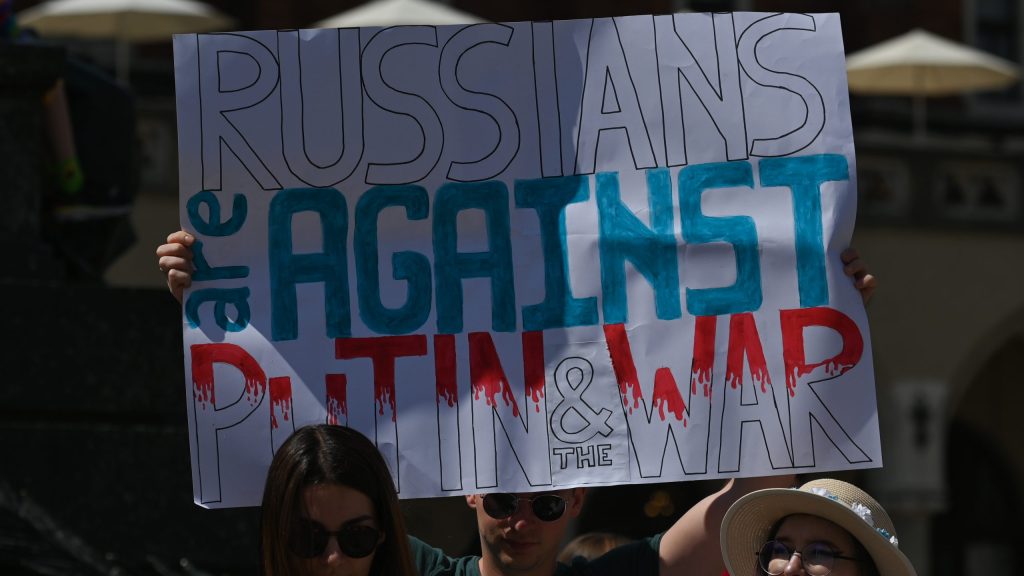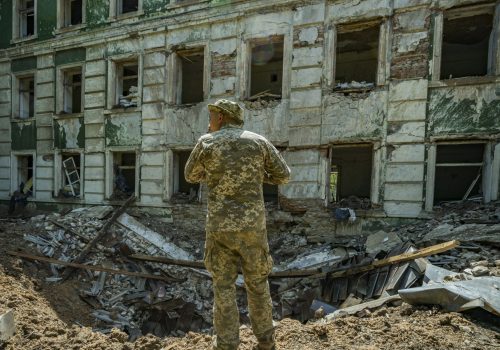The power to sway public opinion is an increasingly essential asset in any state’s toolkit. The war in Ukraine provides a clear example: Ukrainian President Volodymyr Zelenskyy has successfully targeted his appeals at specific Western audiences to strengthen global support for his country.
But the United States neglected that power for many years, focusing instead on military and diplomatic capabilities, while Russia has built its own formidable propaganda machine in a Soviet, Cold War-era mold. Combating it—and therefore undermining President Vladimir Putin’s regime—means proactively promoting truth and high-quality information instead of reactively responding to Russian propaganda. On the home front, the United States must consider a defensive strategy to inoculate domestic audiences against Kremlin information operations that seek to poison American public fora. Today, the information environment is global and the American people are a target audience that is in play in unprecedented ways.
But when it comes to going on the offensive, the Biden administration needs a strategy that focuses on three main audiences: the Russian people, Putin’s military, and contested publics throughout the world. It should be coordinated by a central agency but also draw from a variety of others, including the departments of Defense and State, the US Agency for Global Media (USAGM), the US Agency for International Development (USAID), and the intelligence community. It should also be a key component of the administration’s integrated deterrence approach, which aims to unify all domains of conflict and instruments of national power, and wield transparency as its primary weapon. A key advantage for the United States is its strong technological base, and as the American public increasingly expects companies to take stands on political issues such as Putin’s invasion, these firms should be more motivated to partner with the US government. Demonstrating new technological capabilities could also have a deterrent effect on Russia.
The Russian people
Putin’s regime thrives on the political apathy of its citizens, which stems from the assumption that he has improved their lives—so refuting that tenet is key to undermining him. The Russian people need to be exposed to uncomfortable realities about endemic corruption, a cratering economy, and the horrors in Ukraine; this will expose (and deepen) the existing fault lines in Russian society. Targeting Russians with such a strategy would also open up a new front in the conflict, draining even more of the Kremlin’s resources.
- Penetrating the information bubble. The West should conduct polling and research to tailor custom messages to Russia’s various demographic and ethnic groups to describe how Putin’s regime has failed them, then help embattled media sources, such as the Echo of Moscow radio station, the newspaper Novaya Gazeta, and the independent TV channel Dozhd, to reach their Russia-based audience and evade Kremlin censors. That can be done with online circumvention tools sponsored by the USAGM’s Open Technology Fund, such as the Icarus Project, OpenVPN, or Psiphon.
- Giving voice to Russia’s democrats. Washington should continue to aid Russia’s beleaguered pro-democracy movement—currently centered around Alexei Navalny’s Russia of the Future party and Anti-Corruption Foundation. This would mean helping to amplify their work highlighting rampant corruption in Russia, publicly raising pressure for Navalny’s release from prison, and promoting best democratic practices learned from Hong Kong, Maidan, and other anti-authoritarian movements. The United States should also provide visa and financial support for exiled Russian dissidents, as well as assist the private sector in crafting more precise policies that pressure the Putin regime without compromising their future.
The United States is already engaged in some of these activities, such as promoting anti-censorship tools, but it is missing a clear and comprehensive strategy that would significantly strengthen its effort. It should work with the private sector to create and share the necessary cyber tools, promote the hiring of more Russian-speaking writers and fact-checkers, and reach Russians—especially younger, potentially more Western-leaning ones—on popular social media networks such as VKontakte, Odnoklassniki, Rutube, Telegram, Instagram, and WhatsApp.
The Russian military
The Russian government’s monopoly on information also extends to its citizens in uniform. The United States should lead an effort to break this stranglehold in an attempt to lower their morale. This element of a US strategy could include:
- Demoralizing troops through digital means. In the lead-up to the invasion, widely shared videos of military vehicles helped NATO track Russia’s troop buildup on Ukraine’s borders. Ukraine has also been using private-sector facial recognition technology to identify killed Russian soldiers as well as those believed to have committed war crimes. These efforts can have a damaging psychological effect on Russian troops. The United States should search for innovative ways to capture and utilize data—for example, by tracking online marketplaces for soldiers trying to sell goods they stole while occupying Ukrainian towns and villages—to telegraph to Russian troops that their every move is being watched (and help Ukraine document war crimes). It should also provide technical assistance to Ukraine to complement existing programs for military training and assistance.
- Exposing Russian troops to the truth about their leaders’ orders. Many soldiers were unaware that they would be conducting a full-scale invasion of Ukraine, while some may have moral objections but are unaware of their rights to reject orders. Still others fully believe Putin’s blatantly invented “de-Nazification” narrative. US officials could use location targeting here, too, in order to push media content from independent Russian-language sources on social media and through digital marketing based on the geographic locations of military bases or camps.
With both approaches, the United States must take care to deploy these powerful technological tools in a way that achieves its aims while also respecting core democratic values. This means staying within the bounds of international law and minimizing the chances of setting dangerous precedents for future conflicts.
Russia’s sympathizers
The United States should also aim to influence public opinion globally in order to persuade more countries to isolate Russia. It should increase funding to USAGM—which funds Voice of America and Radio Free Europe/Radio Liberty, important sources of independent journalism in restrictive media environments around the world—and enhance its abilities to reach new audiences through new mediums.
These actions will also require hiring or working with native speakers of the following target countries:
- Former Soviet states. US messaging should strongly imply that they could be the next victims of Russian expansionist aggression. In Central Asian nations, messaging should build upon the historical distrust of competing Russian and Chinese influence in the region.
- United Nations (UN) abstainers. Thirty-five countries abstained from the UN General Assembly’s vote to condemn Russia’s invasion of Ukraine—including some US partners such as India, South Africa, and Vietnam. Russian media narratives thrive in many of these countries, so the United States should aggressively highlight in meetings and other public fora how these countries’ continued support for Russia undermines the principle of state sovereignty. Drawing public attention to Russia’s own oppressive actions in these regions, such as its use of shadowy and brutal mercenaries and how its war against Ukraine is threatening global food supplies, should be another key tactic.
- Contested publics in the West. Politicians and the media in the United States and Europe should call out their colleagues who parrot Kremlin talking points—whether in Hungary, France, or elsewhere—or advocate for policies that will help Putin. To aid in this goal, the United States should publicize financial intelligence that details ties between Putin or his oligarchs and major political or media players in democratic countries, as well as lead an effort to increase transparency around campaign financing.
The United States and its allies have already used some innovative techniques to contest Russia in the information space, such as spilling intelligence in a bid to spoil Putin’s plans. Much of this has been focused on the military side—but it’s now time to take a broader approach that advances US democratic values and prioritizes transparency and truth.
To do this, the United States needs a well-funded, results-oriented strategy to ensure that the world understands exactly what Russia is doing in Ukraine, as well as the global consequences of that aggression. The private sector in the United States has a responsibility to take a leading role in this, and the US government should support and enable the truth—and only the truth—to emerge victorious.
Irina Plaks is a nonresident fellow at the Forward Defense practice within the Atlantic Council’s Scowcroft Center for Strategy and Security.
Further reading
Thu, Jun 9, 2022
Proxy war or not, Ukraine shows why moral hazards matter
New Atlanticist By C. Anthony Pfaff
Whether NATO and Ukraine are proxy partners matters less than whether they can manage the risks associated with their relationship.
Tue, Jun 7, 2022
As Europe withdraws from Mali, Russia gets the upper hand
New Atlanticist By Marie Jourdain, Petr Tůma
While Ukraine has rightfully become the utmost security priority for the EU, it would be a mistake to forget about the bloc's major challenge in the Sahel.
Wed, Jun 8, 2022
Don’t let digital authoritarians lead the way in connecting the world
New Atlanticist By Jochai Ben-Avie
The democracies of the world aren't stepping up enough to connect billions of unconnected people. Here's what they can do.
Image: Members of the local Russian diaspora in Krakow, Poland, join a global anti-war demonstration on June 12, 2022. Photo by Artur Widak/NurPhoto/REUTERS



